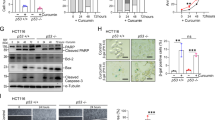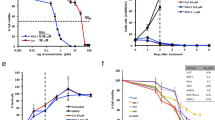Abstract
High expression of epidermal growth factor receptor (EGFR) is found in a variety of solid tumors, including colorectal cancer. EGFR has been identified as a rational target for anticancer therapy. Curcumin, the yellow pigment of turmeric in curry, has received attention as a promising dietary supplement for cancer prevention and treatment. We recently reported that curcumin inhibited the growth of human colon cancer-derived Moser cells by suppressing gene expression of cyclinD1 and EGFR. The aim of the present study was to explore the molecular mechanisms underlying curcumin inhibition of gene expression of EGFR in colon cancer cells. The generality of the inhibitory effect of curcumin on gene expression of EGFR was verified in other human colon cancer-derived cell lines, including Caco-2 and HT-29 cells. Promoter deletion assays and site-directed mutageneses identified a binding site for the transcription factor early growth response-1 (Egr-1) in egfr promoter as a putative curcumin response element in regulating the promoter activity of the gene in Moser cells. Electrophoretic mobility shift assays demonstrated that curcumin significantly reduced the DNA-binding activity of the transcription factor Egr-1 to the curcumin response element. In addition, curcumin reduced the trans-activation activity of Egr-1 by suppressing egr-1 gene expression, which required interruption of the ERK signal pathway and reduction of the level of phosphorylation of Elk-1 and its activity. Taken together, our results demonstrated that curcumin inhibited human colon cancer cell growth by suppressing gene expression of EGFR through reducing the trans-activation activity of Egr-1. These results provided novel insights into the mechanisms of curcumin inhibition of colon cancer cell growth and potential therapeutic strategies for treatment of colon cancer.
This is a preview of subscription content, access via your institution
Access options
Subscribe to this journal
Receive 50 print issues and online access
$259.00 per year
only $5.18 per issue
Buy this article
- Purchase on Springer Link
- Instant access to full article PDF
Prices may be subject to local taxes which are calculated during checkout










Similar content being viewed by others
Abbreviations
- EGFR:
-
epidermal growth factor receptor
- Egr-1:
-
early growth response-1
- EMSA:
-
electrophoretic mobility shift assay
- ERK:
-
extracellular signal-regulated kinase
- FBS:
-
fetal bovine serum
- PPARγ:
-
peroxisome proliferator-activated receptor-gamma
References
Ammon HP, Wahl MA . (1991). Planta Med 57: 1–7.
Andrade AA, Silva PN, Pereira AC, De Sousa LP, Ferreira PC, Gazzinelli RT et al. (2004). Biochem J 381: 437–446.
Arteaga CL . (2002). Oncologist 7 (Suppl 4): 31–39.
Baselga J . (2000). Ann Oncol 11 (Suppl 3): 187–190.
Baselga J, Averbuch SD . (2000). Drugs 60 (Suppl 1): 33–40, discussion 41–42.
Cao X, Mahendran R, Guy GR, Tan YH . (1993). J Biol Chem 268: 16949–16957.
Chauhan DP . (2002). Curr Pharm Des 8: 1695–1706.
Chen A, Davis BH, Bissonnette M, Scaglione-Sewell B, Brasitus TA . (1999). J Biol Chem 274: 35505–35513.
Chen A, Davis BH, Sitrin MD, Brasitus TA, Bissonnette M . (2002a). Am J Physiol Gastrointest Liver Physiol 283: G864–G874.
Chen A, Xu J . (2005). Am J Physiol Gastrointest Liver Physiol 288: G447–G456.
Chen A, Zhang L, Xu J, Tang Jun . (2002b). Biochem J 368: 695–704.
Chen CC, Lee WR, Safe S . (2004). J Cell Biochem 93: 1063–1074.
Chen YR, Tan TH . (1998). Oncogene 17: 173–178.
Ciardiello F . (2000). Drugs 60 (Suppl 1): 25–32, discussion 41–42.
Cohen DM, Gullans SR, Chin WW . (1996). J Biol Chem 271: 12903–12908.
Dancey JE, Freidlin B . (2003). Lancet 362: 62–64.
Davis BH, Chen A, Beno DW . (1996). J Biol Chem 271: 11039–11042.
Fujita T, Asai T, Andrassy M, Stern DM, Pinsky DJ, Zou YS et al. (2004). J Clin Invest 113: 1615–1623.
Gineitis D, Treisman R . (2001). J Biol Chem 276: 24531–24539.
Giri RK, Rajagopal V, Kalra VK . (2004). J Neurochem 91: 1199–1210.
Han SS, Chung ST, Robertson DA, Ranjan D, Bondada S . (1999). Clin Immunol 93: 152–161.
Harja E, Bucciarelli LG, Lu Y, Stern DM, Zou YS, Schmidt AM et al. (2004). Circ Res 94: 333–339.
Hidalgo M, Siu LL, Nemunaitis J, Rizzo J, Hammond LA, Takimoto C et al. (2001). J Clin Oncol 19: 3267–3279.
Huang RP, Fan Y, deBelle I, Ni Z, Matheny W, Adamson ED . (1998). Cell Death Differ 5: 96–106.
Jain N, Mahendran R, Philp R, Guy GR, Tan YH, Cao X . (1996). J Biol Chem 271: 13530–13536.
Janknecht R, Ernst WH, Pingoud V, Nordheim A . (1993). EMBO J 12: 5097–5104.
Jobin C, Bradham CA, Russo MP, Juma B, Narula AS, Brenner DA et al. (1999). J Immunol 163: 3474–3483.
Kamimura M, Bea Florian, Akizawa Tadao, Katus Hugo A, Kreuzer Jörg, Viedt Christiane . (2004). Hypertension 44: 944–951.
Levine AE, McRae LJ, Hamilton DA, Brattain DE, Yeoman LC, Brattain MG . (1985). Cancer Res 45: 2248–2254.
Liu C, Calogero A, Ragona G, Adamson E, Mercola D . (1996). Crit Rev Oncog 7: 101–125.
McMahon SB, Monroe JG . (1995). Mol Cell Biol 15: 1086–1093.
Mendelsohn J . (2002). J Clin Oncol 20: 1S–13S.
Mohan R, Sivak J, Ashton P, Russo LA, Pham BQ, Kasahara N et al. (2000). J Biol Chem 275: 10405–10412.
Mohandas KM, Desai DC . (1999). Indian J Gastroenterol 18: 118–121.
Nishi H, Nishi KH, Johnson AC . (2002). Cancer Res 62: 827–834.
Pan MH, Huang TM, Lin JK . (1999). Drug Metab Dispos 27: 486–494.
Pendurthi UR, Rao LV . (2000). Thromb Res 97: 179–189.
Pendurthi UR, Williams JT, Rao LV . (1997). Arterioscler Thromb Vasc Biol 17: 3406–3413.
Plummer SM, Holloway KA, Manson MM, Munks RJ, Kaptein A, Farrow S et al. (1999). Oncogene 18: 6013–6020.
Ruby AJ, Kuttan G, Babu KD, Rajasekharan KN, Kuttan R . (1995). Cancer Lett 94: 79–83.
Salomon DS, Brandt R, Ciardiello F, Normanno N . (1995). Crit Rev Oncol Hematol 19: 183–232.
Schaefer A, Kosa F, Bittorf T, Magocsi M, Rosche A, Ramirez-Chavez Y et al. (2004). Cell Signal 16: 223–234.
Schmittgen TD, Zakrajsek BA, Mills AG, Gorn V, Singer MJ, Reed MW . (2000). Anal Biochem 285: 194–204.
Thiel G, Cibelli G . (2002). J Cell Physiol 193: 287–292.
Treisman R . (1994). Curr Opin Genet Dev 4: 96–101.
Watson DK, Robinson L, Hodge DR, Kola I, Papas TS, Seth A . (1997). Oncogene 14: 213–221.
Xu J, Fu Y, Chen A . (2003). Am J Physiol Gastrointest. Liver Physiol 285: G20–G30.
Zheng L, Tong Q, Wu C . (2004). J Huazhong Univ Sci Technolog Med Sci 24: 55–58.
Acknowledgements
The work was supported by the grants to A Chen, from Feist-Weiller Cancer Center, LSUHSC-S, DK 47995 from NIH/NIDDK and starting funds from Department of Pathology, LSUHSC-S.
Author information
Authors and Affiliations
Corresponding author
Rights and permissions
About this article
Cite this article
Chen, A., Xu, J. & Johnson, A. Curcumin inhibits human colon cancer cell growth by suppressing gene expression of epidermal growth factor receptor through reducing the activity of the transcription factor Egr-1. Oncogene 25, 278–287 (2006). https://doi.org/10.1038/sj.onc.1209019
Received:
Revised:
Accepted:
Published:
Issue Date:
DOI: https://doi.org/10.1038/sj.onc.1209019
Keywords
This article is cited by
-
Transcriptomic and proteomic analysis of tumor suppressive effects of GZ17-6.02 against mycosis fungoides
Scientific Reports (2024)
-
Comparative analysis of the chrysanthemum transcriptome with DNA methylation inhibitors treatment and silencing MET1 lines
BMC Plant Biology (2023)
-
A novel TGF-β receptor II mutation (I227T/N236D) promotes aggressive phenotype of oral squamous cell carcinoma via enhanced EGFR signaling
BMC Cancer (2020)
-
Friend or foe, the role of EGR-1 in cancer
Medical Oncology (2020)
-
The combination of curcumin and 5-fluorouracil in cancer therapy
Archives of Pharmacal Research (2018)



